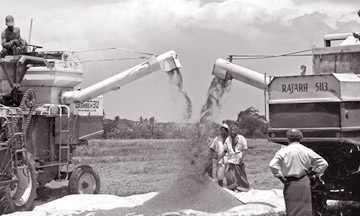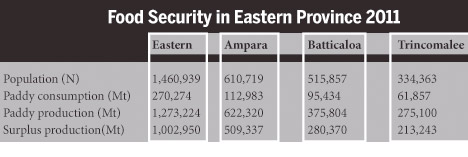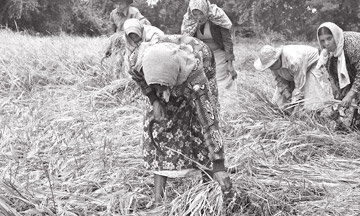|
Following terrorism, tsunami waves and the recent
floods :
Eastern Province success story, the hallmark of development
By Dhaneshi YATAWARA
The Western Province has been contributing 50 p.c. to the total
National economy till recently. But at present it has come down to 45
p.c. Has the Western Province failed? Well, not exactly, according to
the Economic Development Ministry. “This doesn’t mean the Western
Province has failed but it shows that the other regions have started to
contribute more and increase their share in the national economy,”
explained Additional Secretary for Regional Development in the Economic
Development Ministry Nihal Somaweera.
 According
to Somaweera, the contribution of other regions to the overall National
Economy has increased significantly. The entire Eastern Province has
doubled its contribution to the national economy with the Government’s
projects worth nearly Rs. 150 million under the ‘Nagenahira Navodaya’
(Eastern Revival) program. “The Government’s aim is to get the maximum
contribution to the national economy from the more backward regions,”
Somaweera said. According
to Somaweera, the contribution of other regions to the overall National
Economy has increased significantly. The entire Eastern Province has
doubled its contribution to the national economy with the Government’s
projects worth nearly Rs. 150 million under the ‘Nagenahira Navodaya’
(Eastern Revival) program. “The Government’s aim is to get the maximum
contribution to the national economy from the more backward regions,”
Somaweera said.
Beaten up by a ruthless war, then hit by tsunami waves and the recent
floods in 2010 Maha season to 2011 Yala season were the nightmares for
those who lived in the East of Sri Lanka.
Both natural and man-made disasters made life difficult for the
easterners. But as nature blesses the innocent with goodwill, their
harvest never turned bad. Amidst all these drawbacks the East collected
a surplus harvest in paddy production in 2011. This was a true yardstick
for success of the reconstruction, reawakening projects that the
Government launched following the liberation of the area from the iron
clutches of terrorists.
The farmers who suffered from the hazards of elephants and from the
peril of LTTE terrorists, brought their produce to market places
trekking miles and miles in the muddy pathways beaten by rains and
scalded by the pitiless sun. The road network development reduced the
travelling difficulties and resource waste. On the whole, it has
enhanced the connectivity by exposure to a broader arena bringing about
positive changes and modifications in the socio-economic fabric.
Irrigation occupies the prime position among the development work that
was carried out along with road construction development.
A number of programs launched by the government to boost the
agriculture sector in the East has also helped promote paddy production.
The area cultivated under paddy increased from 166,712 ha in 2006 to
267,815 ha in 2010 Yala/2011 Maha, bringing abandoned paddy land also
under cultivation – i.e. 3,933 hectares up to 2010. Similarly, the paddy
production increased from 703,950 Metric tons in 2006 to 1,146,080
Metric tons in 2009. But paddy production decreased to 649,386 Metric
tons in 2010 due to the heavy floods in the Eastern province.
Today, the East populated with 1,460,939 people produces 1,273,224
metric tons of paddy, according to 2011 statistics with the Economic
Development Ministry. In 2011, the surplus paddy production was
1,002,950 metric tons. In Ampara the surplus has been 509,337 metric
tons, in Batticaloa it has been 280,370 metric tons and in Trincomalee
it has been 213,243 metric tons.
 In
Ampara alone 438 irrigation projects have been implemented during the
past few years of which the Rambukkan Oya Irrigation Project is very
significant, according to the Government development plan. In
Ampara alone 438 irrigation projects have been implemented during the
past few years of which the Rambukkan Oya Irrigation Project is very
significant, according to the Government development plan.
These projects provide a new facelift to the district which has 13
very large reservoirs, 9 medium scale reservoirs, and 250 small tanks.
Accordingly, the new projects will enable cultivation of 2,450 acres and
the amount spent by the government for this purpose stands at Rs.
140,194 million.
Providing a better cultivation environment the Government has
constructed 16 fertiliser storage facilities, five Agri Stores, an
Agricultural Training College, and 302 agricultural wells in the Ampara
district which accounts for 20 p.c. of the country’s paddy production,
according to government statistics.
The climatic conditions that prevailed from 2010 Maha season to 2011
Yala season with unusual floods was a drastic setback for the
Easterners, specially farmers. The Economic Development Ministry in
association with local developers, politicians, agriculturists and other
relevant officials worked to find ways and means of overcoming this huge
economic setback.
Locally based scientists who have been responsible for carrying out
an assessment of the eastern disaster, especially in Batticaloa district
on the directives of Economic Development Minister Basil Rajapaksa, have
identified the unprecedented rainfall that Batticaloa received during
just two months, as the reason for the unusual floods.
 Reports
said that more than 40,000 cattle died due to the unusual floods and
this was expected to affect the dairy industry in the east severely.
Destruction caused for food production in the East amounted to 97 p.c.
together with extensive damages to the infrastructure facilities,
particularly to the road network.Yet today, the Eastern Province owns
more than 55,000 home gardens providing strength and nourishment to each
household even in the most rural village. On average, 4.2 metric tons of
paddy per hectare is produced in the district, according to the
statistics available with the Economic Development Ministry. Reports
said that more than 40,000 cattle died due to the unusual floods and
this was expected to affect the dairy industry in the east severely.
Destruction caused for food production in the East amounted to 97 p.c.
together with extensive damages to the infrastructure facilities,
particularly to the road network.Yet today, the Eastern Province owns
more than 55,000 home gardens providing strength and nourishment to each
household even in the most rural village. On average, 4.2 metric tons of
paddy per hectare is produced in the district, according to the
statistics available with the Economic Development Ministry.
In the entire province, during the Maha season in 2011/2012,
approximately 23,234 hactres of land were cultivated with Maize, Ground
Nut, Green Gram, Cowpea and red onions. According to the Economic
Development Ministry, the overall data shows a massive improvement in
ground nut, green gram and cowpea production over the past years.
Vegetables grown in the area also increased from 80,175 ha to 109,830
ha during the period 2006 to 2009. On the other hand, due to floods,
cultivated extent of vegetables declined as 6,123 ha in 2010.
Vegetables are cultivated in Ampara over a 2,347 hactres of land in
Maha season 2011/2012. And in Batticaloa, vegetable cultivated land area
is 568 hactares and in Trincomalee it is 929 hectares. During the Maha
season 2012 the total vegetable production has been 101,687 metric tons.
Divi Neguma, Gama Neguma, Regional growth centres, Strategic
Initiatives, DCB and Foreign Funded Projects directly implemented by the
Ministry of Economic Development have largely contributed to improve and
create village level infrastructure, irrigation, housing, school
buildings and dispensaries.
The Ministry also had direct interventions for providing seeds and
planting materials, agricultural implements aiming at increasing the
agricultural production. Capital was provided to selected beneficiaries
to commence income generating activities.
The mission of the ‘Nagenahira Navodaya’ Program is to double the
regional input to the National Economy by 2016 by way of increasing
investment in propulsive sectors in the East. |

